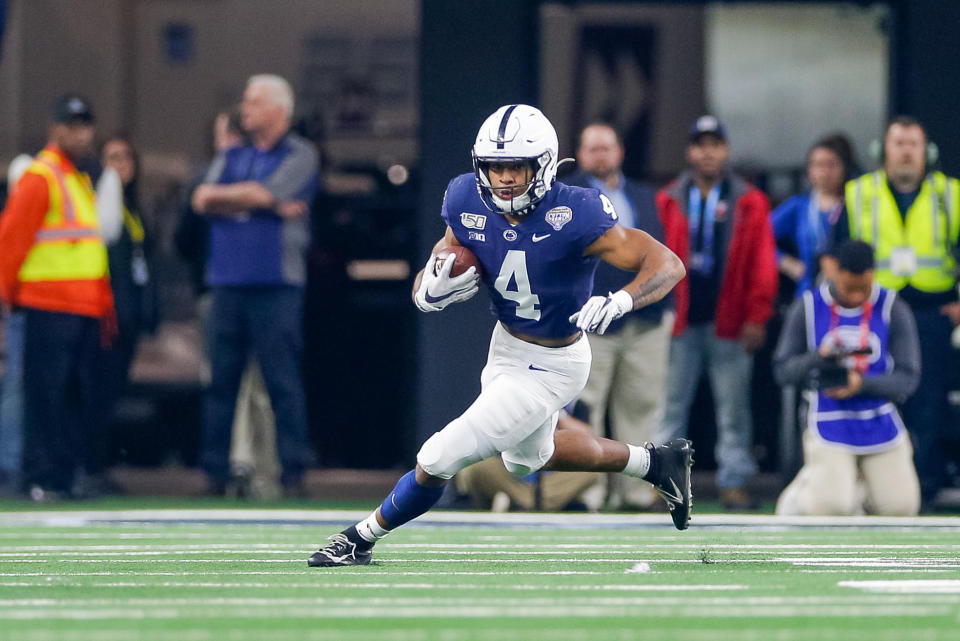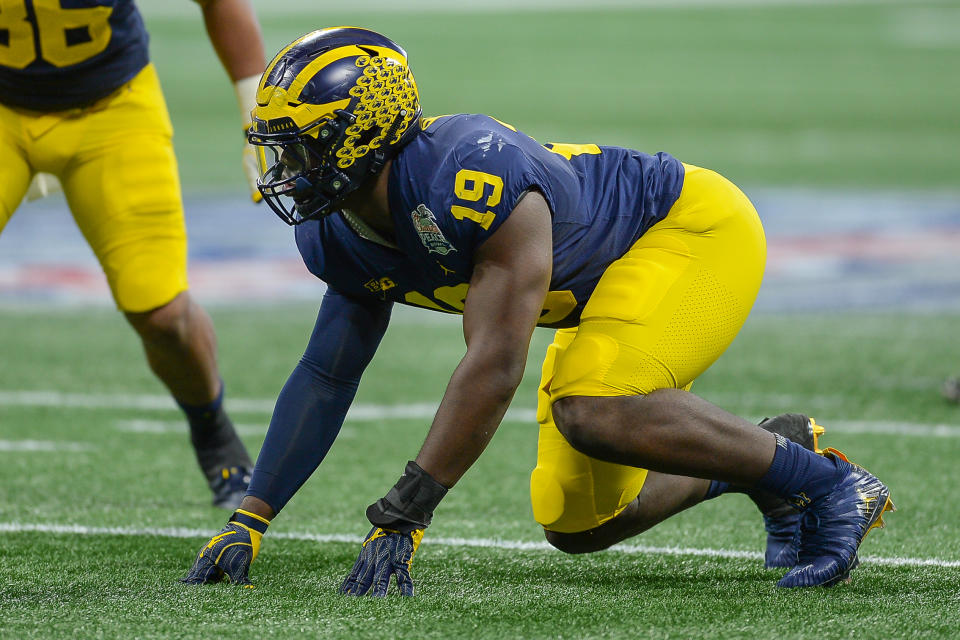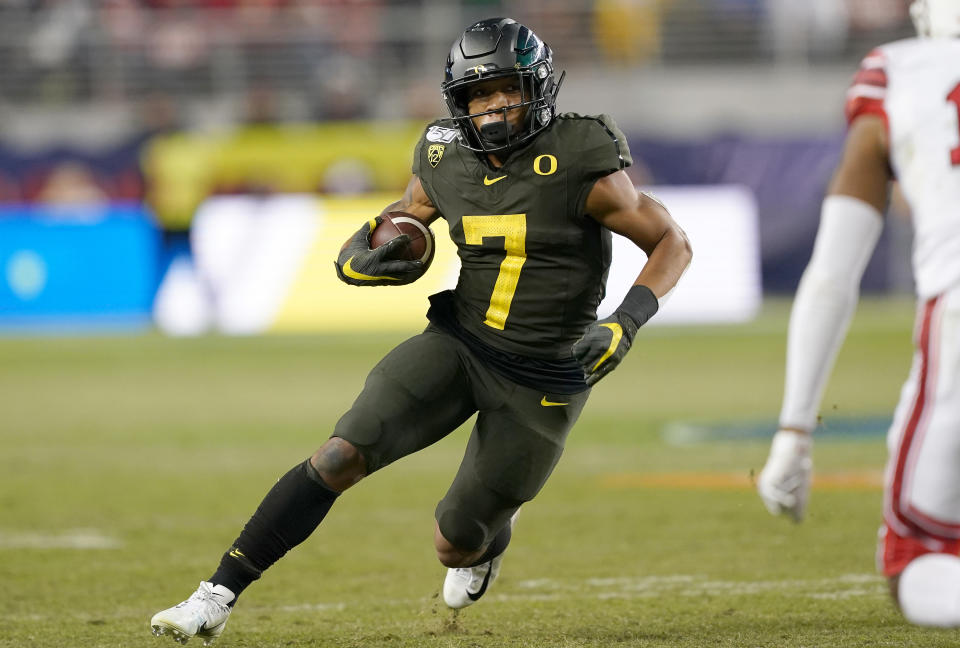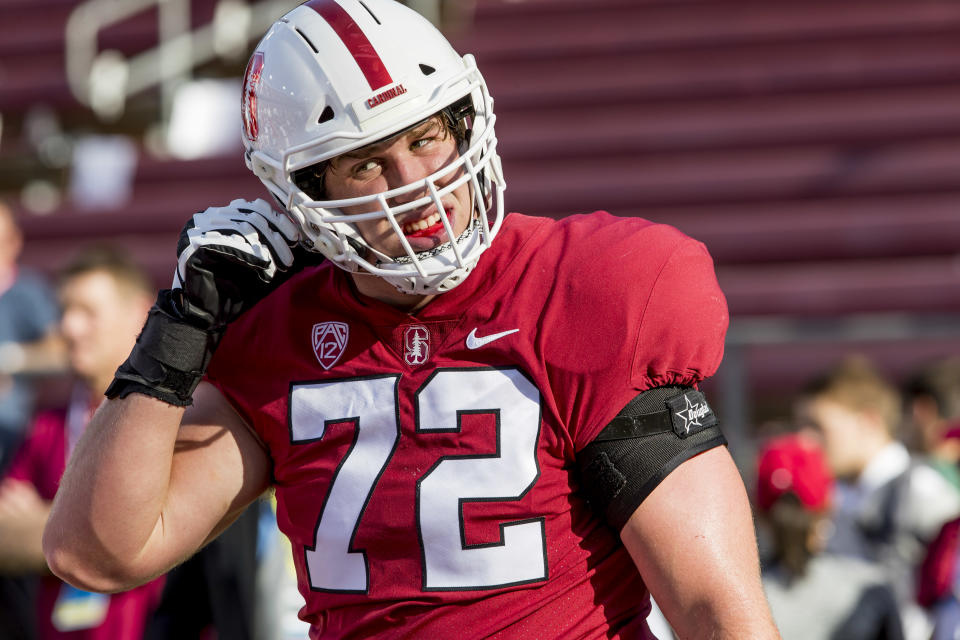NFL draft: Big Ten, Pac-12 prospects hurt most by losing a fall college season
First, the Big Ten announced there would be no fall football. The Pac-12 did the same. Although both conferences have said they’ll look into spring ball, the idea of that happening — and working for draft-eligible players — feels specious now to NFL people.
So there are some draft-eligible players who have likely played their last snaps of college football, and it could hurt their chances to improve their draft stocks.
Some top-tier prospects, such as Penn State linebacker Micah Parsons, already have opted out of college football and will declare for the 2021 draft early. In Parsons’ case, his play the past two seasons likely will have him drafted very high next year.
Others from the Big Ten and Pac-12, however, currently have more volatile draft stocks. Here are the players from each of those conferences for whom no fall football will hurt the most from an NFL draft perspective.
Big Ten prospects
Minnesota QB Tanner Morgan (redshirt junior)
Morgan first was stung when his expected top target, WR Rashod Bateman, opted out. Then, the conference news dropped. Now, Morgan has a decision to make: stay in school for another season — either spring or fall of 2021 — or come out following a strong 2019 campaign.
His play took a big jump from the year prior, and his clean mechanics and accuracy are strong selling points. But Morgan also needs to develop better positional instincts (situational play, taking too many sacks) and will face questions about his arm talent.
His decision won’t be easy. He currently sits near the high middle of the draft pack for the 2021 eligible passers. He turns 22 in April.
Penn State RB Journey Brown
Expected to be the next in the recent lineage of talented Nittany Lions backs following Saquon Barkley and Miles Sanders, Brown has a tricky call to make.
With only 443 college snaps to his name, Brown doesn’t have a lot of tape to rest on. What he has displayed in limited duty has been impressive, as the 5-foot-11, 216-pound Brown can maintain his balance on contact, flashes underrated quickness and was a monster down the stretch last season (593 rush yards, nine TDs in PSU’s final five games).

With some scouts saying Brown could challenge for RB1 duties in the 2021 class, the opportunity might be gone now. Could Brown stay in school? Sure. It just won’t be an easy call, and coming out means there’s only so much he has proven on the field.
Ohio State RB Trey Sermon
This isn’t a catastrophic development, but you wonder whether Sermon retroactively regrets transferring from Oklahoma to Ohio State. No way he could have predicted the fall season being nuked, but Sermon now misses out on what could have been a bell-cow role. At OU, to be fair, he would have shared duties again with the talented duo of Rhamondre Stevenson and Kennedy Brooks.
Sermon has strong, three-year production to fall back on: 339 carries, 2,076 rush yards (6.1-yard average) and 22 TDs. But the 6-2, 216-pound back lost snaps at OU in 2019 and then was sidelined with a knee injury. Landing at Ohio State was supposed to offer him the springboard opportunity into the NFL in an offense that produced a 2,000-yard back in JK Dobbins a year ago.
Right now, Sermon figures into the third- or fourth-round spectrum.
Michigan RB Chris Evans
The 2020 season was supposed to be a redemption opportunity for the talented Evans who was suspended for the entire 2019 season for academic reasons but welcomed back into the fold this winter.
Evans worked three jobs and improved his academic standing in order to get back into the coaching staff’s good graces, and that work will benefit his cause in the eyes of NFL scouts, too. But the senior could be missing on a chance to remind people of his talent, which was on display in 2016 through 2018.
Although never a workhorse, the 5-10, 210-pound Evans had some eye-opening games — especially in 2017 — and has some third-down potential as a pass catcher. Summer scouting grades currently have him in the Day 3 range, so perhaps Evans is a sleeper to remember.
Iowa WR Ihmir Smith-Marsette
With the senior’s eligibility gone, only a spring season — don’t hold your breath — can do a ton to change Smith-Marsette’s draft stock. Although his quickness, fluid route running and natural ability to separate are impressive, he has also displayed trouble getting off of press coverage and had a late-season spell of drops last season (three vs. Wisconsin).
Smith-Marsette looks like a Day 2 prospect, but it figures to be another strong crop at receiver, and his lean frame is something that could be held against him. Perhaps spending time adding weight and strength is the blessing in disguise he needs in lieu of a full season.
Smith-Marsette’s stock is based on potential upside, and he had a chance to improve that stock with a more productive final season. He entered 2020 with only one game with more than four receptions and three career outings with more than 72 receiving yards.
Michigan WR Nico Collins
There’s a lot of excitement about the 6-4, 216-pound Collins in NFL circles, earning some impressive early grades despite catching only 78 passes in his three seasons in Ann Arbor. Collins returned to school believing he had unfinished business, only beginning to consistently flash his game-changing talent.
Could Collins still end up a first-round pick? It’s possible. Without the benefit of being the alpha dog in Michigan’s offense this season, there is still an incomplete body of work. One of his best games in 2018 came against Ohio State (4-91-2 receiving). He was held to two catches (with a drop) against the Buckeyes’ talented secondary a year ago.
One of the biggest questions about him is his speed, so perhaps entering pre-draft training and gearing up sooner for the 40-yard dash will help him down the road. It’s unfortunate that Collins wasn’t able to prove himself as a WR1 on the field for the Wolverines.
Penn State EDGE Jayson Oweh
Routinely listed on summer “breakout player” lists, Oweh was impressive last season in a limited role and appeared poised to surpass the level 2020 second-rounder Yetur Gross-Matos rose to last season.
Now Oweh — a redshirt sophomore — must decide whether to come out or wait until the next draft cycle. With a strong 2020 season, the 6-5, 253-pound pass rusher had a path to land in the first round.
He has a mere 397 college snaps, so his tape collection is extremely lean. Even with Oweh’s shocking athleticism, reportedly running a 4.33-second 40-yard dash at Penn State, he hasn’t done much on the field in college. He has a tricky call.
Michigan EDGE Kwity Paye
Like Oweh, Paye’s calling card is his athleticism — along with exciting pass-rushing potential. What the 6-4, 271-pound Paye has in his favor is more of a pro-ready frame and more experience, having played extensively the past two seasons. Paye logged 12.5 tackles for loss and 6.5 sacks in 12 games last year.

Earning second- and third-round projections this summer, Paye is losing only so much by not playing his senior season. Additionally, his excellent workout numbers at Michigan, including an absurd 3-cone time (6.37 seconds) for his size, would appear to make Paye a future scouting combine standout.
Still, putting one more strong season on tape for the former Liberian refugee could have vaulted him into the no-doubt, first-round discussion. That still could happen, but it’s not a certainty just yet.
Michigan State DT Naquan Jones
A part-time defender the past three seasons, the 339-pound Jones was expected to be one of the breakout players on a Spartans defensive line that lost three of four starters to graduation. DL coach Ron Burton said he expected Jones to “double his snaps” from the 267 he averaged his first three seasons.
Given his limited experience and minimal production as a rotational player, Jones was earning mostly Day 3 grades entering this season but was expected to be able to rise with a showcase performance. Now that’s gone. He’ll have to find another way to prove his worth to NFL scouts.
Ohio State LB Baron Browning
Browning has intrigued scouts despite not being a full-time performer for the Buckeyes. The assumption was that he was going to take on a more prominent role this season, so without that chance, Browning’s projection is more tricky.
The 6-2, 245-pound senior was best in a blitzing role the past few years. He has a natural knack for taking good paths to the quarterback and making disruptive plays. Browning’s all-around linebacker skills remain undeveloped.
He seems to be in that Round 2 picture now. Can he make up ground without a season?
Northwestern LB Paddy Fisher
Fisher has been well-hyped since his breakout season in 2017, and many have made the point that the 6-4, 246-pound linebacker is a perfect on-field reflection of his coach, Pat Fitzgerald. As a big hitter and instinctive run stopper, Fisher checks off some nice boxes.
His tackling, however, is a concern. He misses far too many, allowing ballcarriers to get through his grasp while he tries to make knockout blows (see the final two games last season).
Fisher’s pass coverage isn’t the liability some would have you believe; he was actually pretty darned good in zone last year. All signs pointed to a big final season for the Wildcats as the leader of the team’s defense, but now it appears that chance is gone. He’s in the early Day 3 range.
Indiana S Marcelino Ball
The redshirt senior is supremely underrated. All he does is fly around and make plays, operating from a hybrid nickel corner-safety-linebacker role. Ball is good in coverage, plays with intense physicality and can bring that versatility to an NFL team in multiple ways.
Why didn’t he even make Big Ten honorable mention last season? We have no clue. He profiles as a valuable sub-package defender and special-teams standout, but now might not have much chance to improve on his Day 3 projection prior to the NFL scouting combine.
Pac-12 prospects
California QB Chase Garbers
A redshirt junior, Garbers is believed to be Senior Bowl-eligible if he enters the 2021 draft picture. He was expected to benefit from the tutelage of former NFL QB and coordinator Bill Musgrave this season, so Garbers might stick around in 2021.
The 6-2, 205-pound passer has nice first- and second-level accuracy and is a good athlete for the position, able to move well in the pocket and pick up first downs by scrambling.
Garbers’ arm strength is in question, and his experience has been limited by opportunity and injury.
He has a tough call coming up, but staying in school might be the safer play.
Oregon RB CJ Verdell
With some Day 2 projections, the 5-9, 205-pound Verdell could come out now as a redshirt junior following a strong finish to the 2019 season. After being slowed by injuries earlier in the year, Verdell roasted Utah’s talented defense — featuring several NFL talents — with an 18-carry, 208-yard, three-TD performance (including scores of 70 and 31 yards) in the Pac-12 title game.

He’s a bursty back with intriguing big-play potential. What Verdell could have shown more of this season: pass-catching prowess and more patience as a runner. It’s a mystery why Verdell wasn’t used more extensively as a receiver last season after flashing some of that ability in 2018, but his pass-protection limitations were one reason he wasn’t on the field more on third downs.
Those questions could linger if he comes out early.
USC WR Tyler Vaughns
Vaughns might not have been the Trojans’ No. 1 receiver this season after playing the role of Michael Pittman’s talented sidekick last season; that role could have gone to talented underclassman Amon-Ra St. Brown. There’s an argument that any receiver featured at USC with QB Kedon Slovis would be in line for significant work.
That’s why the 6-2, 188-pound Vaughns losing this season could hurt the senior. There’s appreciation for his skills in NFL circles, and he could find himself entrenched in the back end of the top-100 picture. If Vaughns displayed better speed, more separation and big-play ability this season, he might have shed his reputation of being a station-to-station possession receiver.
Arizona State WR Frank Darby
Both N’Keal Harry and Brandon Aiyuk turned themselves into first-round prospects with big final seasons in 2018 and 2019, respectively, and Darby had the chance to be the next in line for a big bump for the Sun Devils.
His frame is on the lean side, and Darby could stand to be a bit more physical in his approach because he has the strength and explosion to do so readily. There’s a talented prospect just waiting to blossom, with terrific quickness, ball-tracking ability and outstanding feet.
The senior figured to be talented QB Jayden Daniels’ go-to target this season, so it’s a big loss for Darby after he built so much momentum late last season. In a four-game span last November, Darby caught 16 passes for 387 yards and seven touchdowns. He is a better player than the Day 3 grades he received over the summer, so he’ll have to prove himself in other ways.
Washington State OT Abraham Lucas
The 6-7, 325-pound Lucas was a player we had our eyes on entering last season as a potential first-round pick. He has work to do and will face questions — the same ones former Cougars OT Andre Dillard did entering the league — about his run-blocking prowess and traditional pass-set ability, coming from an Air Raid system.
There’s a lot to like about Lucas’ potential, and the 2021 draft is shaping up early as a less-clear one at offensive tackle. But Lucas will have a call to make: stick around for a redshirt senior season in 2021 or come out with two very intriguing years’ worth of tape at right tackle.
Stanford OT Walker Little
A year ago, many felt Little was on track toward a first-round projection, giving the look of a classic NFL left tackle. He was terrific in 2018, dotting many preseason All-America lists entering 2019, but Little suffered a knee injury late in the opening game against Northwestern and missed the rest of last season.

Little opted to return to school this year and still had a path to landing in Round 1. With the injury questions and some sub-par reps against quality speed rushers, Little also had some work to do. Will he stick around or come out? He turns 22 in March and might be itchy to get into the league and avoid another injury.
Fellow Cardinal redshirt junior Drew Dalman also has a tough call; he’s undersized but a terrific technician and mauler at center who could have vaulted up draft boards with a strong 2020.
Oregon State EDGE-LB Hamilcar Rashed
The 6-3, 248-pound Rashed figured to be one of the more polarizing prospects in next year’s class. His disruptive production — 22.5 tackles for loss, 14 sacks and two forced fumbles in 2019 — is outstanding. His pro projection is less clear.
Rashed announced his return to school before last draft cycle and was being projected as a third- or fourth-round player entering this season. Can he stack and shed at the next level? Bulk up and still be productive? Refine his pass-rush arsenal? Develop further as a two-point-stance defender?
All those questions linger now. He’s a fascinating prospect but one with an incomplete evaluation.
Washington LB Joe Tryon
When you see the jump Tryon made from his 2018 season (two tackles for loss, one sack) to what he did in 2019 (12.5 tackles for loss, eight sacks), it’s easy to see that he’s considered an ascending player. An even bigger 2020 season was anticipated by many.
Tryon is as a mid-round prospect, but it’s hard not to wonder where the 6-4, 262-pounder could have been after another productive season. He has a nice height-weight-speed quotient and some versatility to his game, but scouts were hungry for more — especially in expected tests against top Pac-12 tackles such as Little and Oregon’s Penei Sewell.
Colorado LB Nate Landman
When we visited Buffaloes camp last summer, we were there to write about QB Steven Montez, WR Laviska Shenault Jr. and DL Mustafa Johnson. But the name that kept coming up was Landman, who remains supremely underrated outside of Colorado or conference circles.
It was surprising to hear that Landman was earning mostly Day 3 grades this summer, as he has a chance to be a solid “Mike” linebacker at the next level. His football IQ and effort are off the charts, even if his athleticism and size are considered average for the league.
Still, Landman’s coverage improved down the stretch, and he’s the kind of try-hard performer who can make tangible improvements to his weaker areas. Without a senior season, the road to do so has become tougher.
California LB Kuony Deng
Deng remains in the “fascinating prospect” category, rather than being a refined athlete. The 6-6, 235-pound Deng is also a curiosity, possessing great length but also a positional-fit question at the next level.
Deng had a few rough patches in coverage, getting nickeled and dimed against UCLA and a few other teams. Can he cover in the NFL? Do you want him on the edge? Covered up between the tackles? Scouts appear unsure of his pro fit, and he’s viewed as a later Day 3 prospect.
There were enough fascinating elements to Deng’s game, including some surprising strength and his freaky length, that a big senior season might have boosted his stock a notch or two.
Arizona CB Lorenzo Burns
Earning Day 3 and UDFA grades, Burns entered 2020 with a final chance to prove he’s better than that. Burns has been a ballhawk for the Wildcats, picking off five passes in 2017 and four more in 2019, also getting his hands on a lot of other passes.
His size is a concern at 5-11 and 175 pounds. He has taken a beating on the college level, missing time here and there with minor ailments.
Burns has played mostly outside corner at Arizona, and yet his pro projection figures to be inside in the slot with such a lean frame.
More from Yahoo Sports: